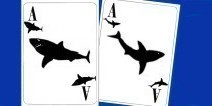Hold'em Starting Hands

This article discusses the concept of starting hand chart.
For those of you who want useful starting hands charts, we wrote
a special report named "Starting Hands Revealed". You can get a pdf copy
by simply putting your first name and email address in the box on the left.
This article is for poker beginners or intermediate players who seek a general description of what is meant
by a starting hands chart & the conditions on how to use them.
If you are an intermediate or advanced player looking for a slightly more sophisticated discussion of starting hands charts,
please check our advanced starting hands
article.
The first step in Texas Holdem is to determine which hole cards you will fold, call or
raise preflop. This list should be very consistent over time as this is the anchor of
disciplined poker.
The cards that you play preflop are called the starting hands.
If you follow a specific strategy with respect to starting hands, you are going to
use a starting hand requirement chart that is like a pilot checklist.
There is no universally agreed starting hand chart and there cannot be.
If such a list existed, some players would take advantage of the "predictability" of
the list to their advantage. Also all players or authors do not agree with their top ten or top
twenty hands, but the differences are minor.
Furthermore one of the advanced poker tactic is to "mix" one's
game, i.e. to change gear from time to time, which imply that the starting hands requirement
will change as well.
What is a Starting Hands Chart?
Whatever your approach, when you become an advanced player, you may include some
flexibility
depending on variable conditions such as the other players at the table or your table image.
But at the beginning it is strongly recommended to follow a precise starting hands chart in
order to avoid sloppy moves due to boredom or desperation. We provide below
general guidelines about how to design your starting hands chart.
Note that a preflop strategy depends to a great extent on
understanding position. As your position rotates
around the table from under the gun toward the button, there are less and less players
representing a threat behind you and it becomes safer to play a wider range of hands,
because less bad surprises can strike you.
Poker is a game of "imperfect"
information, and late positions offer more information than early positions.
From a given position such as UTG+2, your action will depend on the actions of the players
acting prior to you, such as who limped, fold or raised before you have acted.
A precise and complete starting hand chart requires a table including multi-cases and
can be quite complicated and include many details. For instance it could include 5 cases such
as "you are first to act", "a few limpers before you", "just one raiser before you",
"one raiser and a few callers", "one raiser and a reraiser in front of you".
We address
this question in detail in the
advanced section, but for now we will present general
guidelines about starting hands addressed to beginners or intermediate players.
Winning Poker Hands
In Playing Poker like the Pros,
Phil Hellmuth presents his list of the top ten hands {AQ+,77+}, which stands for AQ or better
i.e. AQ and AK, plus 77 or better i.e. all pairs 77 or higher. His list of the top 15 hands is
{AQ+,22+} i.e. he adds all low pairs to the top ten list. This list is easy to remember, albeit effective
Note that he does not distinguish
if AK or AQ are suited or not, and you do not need to worry about that when you start thinking
about starting hands, as the difference in expected value between A♠K♠ and A♠
K♣ is tiny.
On average you will get cards from Phil's
top 15 list 8.3% of the time. If you are looking for winning poker hands when starting to play
texas holdem on the Internet, use the top 15 list, which will give you a
VPIP=8.3%, quite tight
but adequate at the beginning.
As was said earlier position is crucial, so the second step when you develop your starting hand chart
is to think about incorporating position into the equation.
Let us see how we can modify the top 15 list to make it more flexible. In early position,
play only {AK,99+} to be ultra cautious. In middle position, play the top 15 list. In late
position, be looser and play {A7+,KT+,QTs+,22+}, i.e. add weaker aces and ""Broadway cards" to
your range.
Note that odds calculators such as
tournament indicator and
Texas Calculatem
let you see the strength of your hole cards.
And let us say for discussion sake that in the small blind you end up playing 33%
of your hands, which means that you complete the small blind in unraised pot most of the time and play
very tight otherwise. Similarly you play the big blind very tight, meaning that you only call
raises from the BB with {AK,99+}.
Following this simple
starting hand chart implies VPIP=12% in a 9-handed game, an improved starting hands strategy, less tight
and including position-dependence. Make sure to use a
poker HUD
when playing poker on the Internet if you want such statistics to be displayed for you.

Which Hands to Raise Preflop?
The next step in developing your starting hand chart is to select which hands
to raise with. Let us say that from early position, you raise our entire range {AK,99+} because
if you limp this is an invitation to be raised by a late position player and forced to play out of position.
From middle position, you raise {AQ+,77+} if no one has raised before you. From late position, you raise
{A9+,KQ,55+} if no one has raised yet.
Note that we made the raising range slightly looser as
we rotate toward the button. From the blinds, we raise the same range as from early position
because the blinds are the first to act post flop, so they can only raise with premium hands.
On average if you use this method, opportunities to raise will present themselves 7.9% of the time.
Following this starting hand chart both for calling and raising hands corresponds to a
VPIP/PFR around 12/8. These are very respectable
tight-aggressive statistics suitable for beginner or intermediate players.
Additionally, refinements can be added such as deciding what action to take if the pot is raised
before you or if you get reraised. As a texas holdem player seeking to improve your skills,
it is fundamental that you develop your own starting hand chart and that you follow it with
unequivocal discipline.
Phil Hellmuth specifically designed the range detailed above for Texas Hold'em
poker beginners. In Caro's Most Profitable
Hold'em Advice, Mike Caro presents his own top holdem hands list. His top ten is {AK,AJs+,TT+}.
You can see that he gives more weight to big suited aces and less to medium and low pairs. His top 15 list
is {AQ+,KQ,ATs+,KJs+,99+}, which has additional big aces & big kings plus 99.
Mike Caro favors big face
cards versus medium pairs, which make sense as usually Broadway cards dominate medium pairs unless
the latter make a set. As you evolve as a holdem player, you can experiment with your starting hands
charts and determine what suits you best.
Mike Caro is a member of DoylesRoom's team.
Join DoylesRoom now, and
you will have a chance to play against Mike Caro or even Doyle Brunson himself.
|














